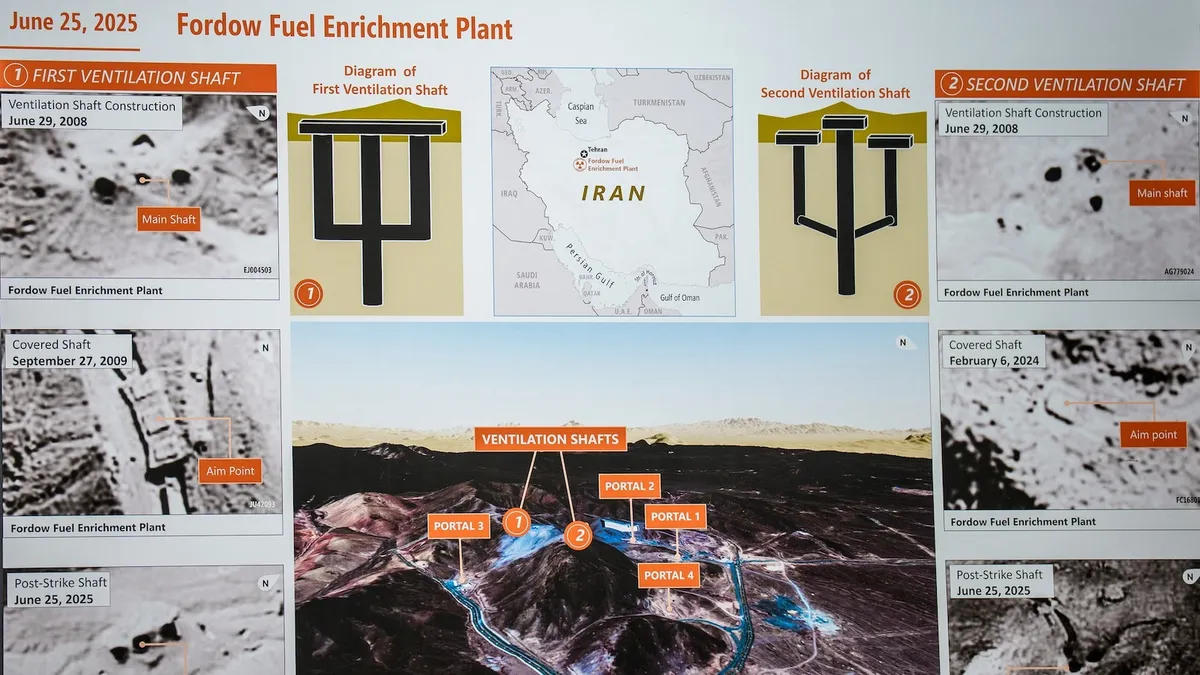
On Thursday, the Pentagon made an unprecedented move by releasing extensive details regarding the military's covert operation targeting Iran's nuclear facilities and the defense of a U.S. airbase in Qatar. This unusual disclosure comes amid rising scrutiny over the effectiveness of the U.S. strike, which specifically targeted three Iranian nuclear sites on June 21. The White House, frustrated by ongoing questions regarding the strike's success, orchestrated these revelations. President Trump asserts that Iran's nuclear program has been significantly crippled, although preliminary military assessments indicate that the strike may have only delayed Iran's nuclear ambitions by a matter of months.
The operation against Iran's Fordo nuclear facility was the culmination of a highly classified, 15-year mission. In 2009, a U.S. officer from the Defense Threat Reduction Agency was introduced to classified imagery of a construction site deep within the Iranian mountains. General Dan Caine, chairman of the Joint Chiefs of Staff, revealed that this officer and a colleague dedicated the next 15 years to studying the location. They meticulously analyzed the site's weather patterns, geological features, and discarded materials while paying close attention to ventilation shafts and electrical systems. Caine described how the analysts became so engrossed in their work that they "literally dreamed about this target at night."
Recognizing that existing weaponry was inadequate for a strike on Fordo, the analysts collaborated with industry experts to develop the Massive Ordnance Penetrator (GBU-57), specifically designed to penetrate hardened targets. On June 21, 2025, over a decade and a half since the mission's inception, the President ordered the B-2 bombers to execute the strike. Caine recounted the astonishment of the analysts upon receiving the order, stating, "I can't even get my head around this."
During the briefing, it was revealed that 12 of the 14 Massive Ordnance Penetrators deployed on June 21 were aimed at the Fordo facility. Caine elaborated that six bunker-buster bombs were dropped into two ventilation shafts, which had been sealed with concrete caps. The initial bomb successfully removed these caps, allowing the subsequent bombs to penetrate at speeds exceeding 1,000 feet per second, detonating within the target area. Caine emphasized that all six bombs hit their intended marks, resulting in a devastating mix of overpressure and blast that wreaked havoc in the tunnels and destroyed critical infrastructure.
Witnessing the explosion from their aircraft, fighter pilots reported that the detonation was so bright it resembled "daylight." This vivid description underscores the magnitude of the strike on the Fordo facility.
Following the bombing, the Defense Intelligence Agency (DIA) produced an early assessment indicating that Iran's nuclear program had been delayed by several months. However, insiders noted that the attack primarily caused damage to above-ground structures, leaving lower-level facilities largely intact. This raises significant questions about the overall impact on Iran's nuclear capabilities, particularly concerning the remaining enriched uranium. Despite President Trump's claims that no uranium was relocated prior to the strikes, conflicting reports suggest otherwise.
Defense Secretary Pete Hegseth expressed frustration over the leaking of the DIA report, which he claimed contradicted earlier assessments, stating that new intelligence suggests that Iran's nuclear program has been set back by years rather than months. Hegseth also mentioned that the report had not been coordinated with the intelligence community and was classified as low confidence.
In the wake of the strike, U.S. officials intercepted communication indicating that Iran was preparing to retaliate against the al-Udeid airbase in Qatar. In response, military officials swiftly evacuated many personnel while leaving behind two Patriot missile batteries and approximately 44 soldiers, predominantly in their 20s, to defend the base. General Caine noted that the oldest service member among them was a 28-year-old captain. The remaining troops, facing extreme conditions, were instructed to keep their missile systems directed north as Iranian forces began launching missile strikes.
Caine characterized the defensive operation as the largest single engagement of Patriot missiles in U.S. military history, highlighting the collaborative efforts of Qatari forces in this defense. Although the exact number of rounds fired remains classified, Caine assured that it was a substantial quantity, underscoring the intense nature of the confrontation.
As more information emerges regarding the Pentagon's operations and assessments, the implications for U.S.-Iran relations and global security remain a focal point of discussion among military and political analysts.